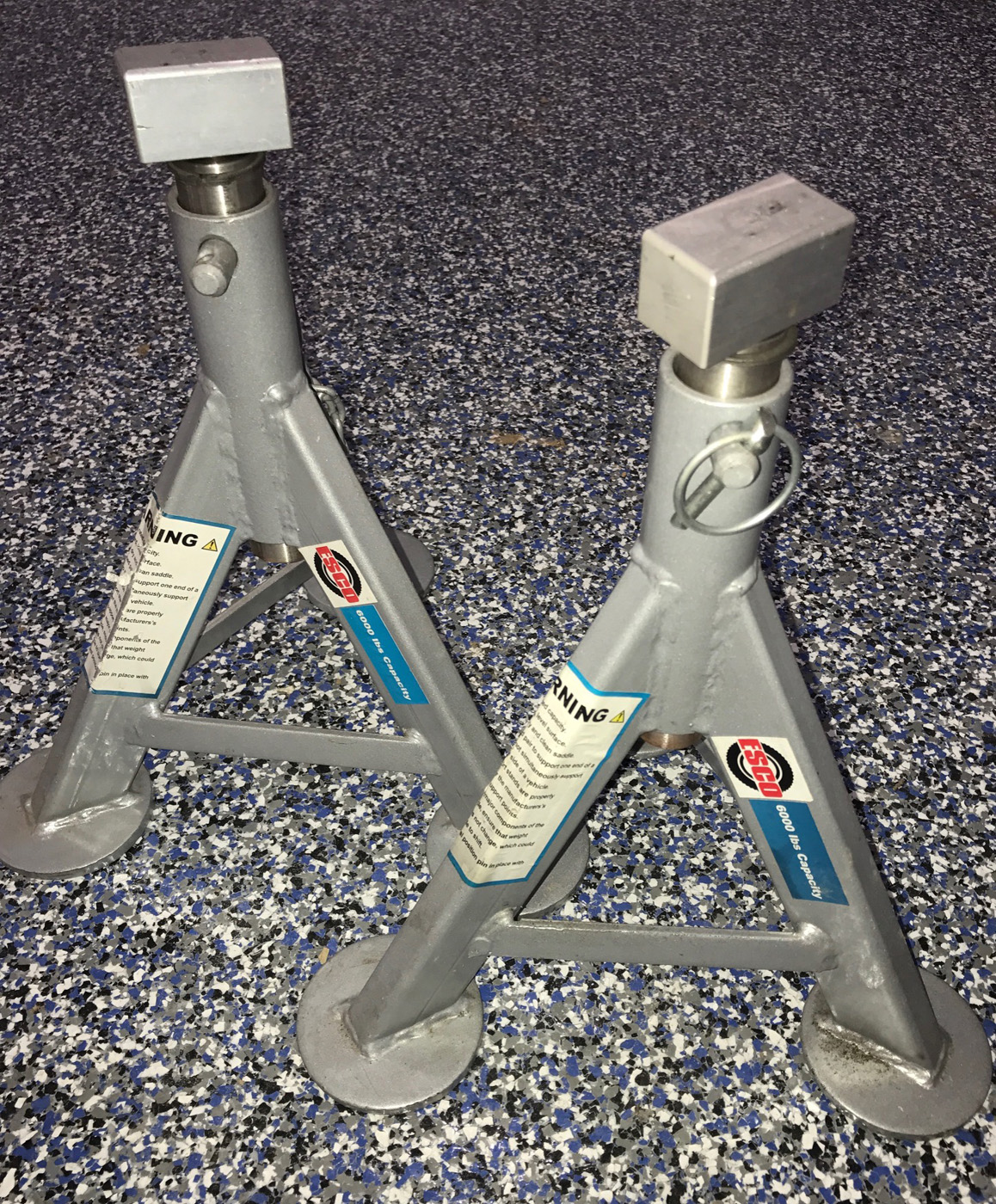There have been several posts requesting information about how to store an i3 long-term. I stored our i3 for slightly more than 5 months and have some observations to report.
On 14 April, I folded in our i3 BEV's side mirrors, lifted our i3 onto jack stands to prevent possible tire flat-spotting and dry rot (possibly at the expense of increasing the risk of rusting the fully-extended shock absorbers' shafts in our humid, salty air), disconnected the negative cable of its 12 v. battery (to prevent it being fully discharged and destroyed by parasitic loads), closed but did not latch its frunk (so I could open the frunk upon our return without using the emergency release cord and reconnect the 12 v. battery), placed its antenna and front and rear windshield wiper blades inside the car (no antenna hole in our cheap car cover, and blades suffer after being pressed against glass in the same position for several months), locked the car with the emergency key in the fob, and placed a car cover over it to prepare it for in-place storage in our condo parking garage parking space. Our parking space is not exposed to direct sunlight or rain, but it is exposed to warm, salty, outside air since the parking garage has open sides.
I purposely decreased our i3's high-voltage battery pack's charge level to ~55% (estimated from the charge level bars since I don't have the latest software that displays the charge level percentage) from 88% (reported by iRemote) by running the A/C on max with the high-beam headlights on for ~3 hours while I washed our car, lifted it onto jack stands, and prepared it for storage. I believe that storing a Li-ion battery pack at a high charge level is detrimental to its long-term health. I would have preferred to have stored the battery pack at ~40% but I ran out of time to discharge it further. I did not measure the voltage of the 12 v. battery, but I assume it must have been fully charged at ~12.7 v. Unlike a Li-ion battery pack, an absorbent glass mat Pb-acid battery is better stored at full charge.
The following morning, we boarded a plane to start our long journey to Sweden where we would spend the next 5 months. I left without being concerned about how I stored our i3 despite not following BMW's recommendations because I have been storing our Honda Insight hybrid and former Mitsubishi i-MiEV in the same way since 2008 with absolutely no ill effects. But I wouldn't really know how our i3 fared until we returned in September…
On 24 September, I put our i3 back in service. I took off its car cover, replaced its antenna and windshield wiper blades, opened its frunk, and measured its 12 v. battery's voltage: ~12.5. While not fully charged, it had plenty of charge to boot our i3's computers. I assumed that the 12 v. battery would be charged when the high-voltage battery pack was being charged prior to driving, so I did not charge the 12 v. battery with my battery charger. I reconnected our car's 12 v. battery's negative terminal and entered our car via Comfort Access.
I then pressed the "Start" button to put our car into "Radio" mode so that I could read the high-voltage battery pack's charge level. I was somewhat surprised that the charge level was shown as ~35%, ~20% lower than when I had parked the car more than 5 months earlier. Unfortunately, I could not force iRemote to refresh, so it continued to report the battery pack's 88% charge level as of 14 April before I discharged it to ~55%.
The i3 must be displaying an estimate of its battery pack's charge level after the 12 v. battery has been reconnected which might be based on its battery pack's voltage and temperature. This estimate might not be particularly accurate due to the poor correlation between charge level and voltage in the middle of a Li-ion battery pack's charge level range. I characterized this as an estimate because I am not aware of any reason why the battery pack's charge level should be less than when I parked our car more than 5 months earlier. Li-ion battery packs have a very low self-discharge rate at the storage temperature of our car which probably averaged ~75º, and the battery pack should have been electrically isolated during storage, so it couldn't have been discharged by external loads.
When I plugged in our JuiceBox EVSE, the voltage at the 12 v. battery's terminals increased to 14.3 v. which confirmed that the 12 v. battery is charged while the high-voltage battery pack is being charged. Our EVSE reported that 10.5 kWh of energy was added to fully charge our i3's battery pack. That is insufficient energy to increase the reported 35% charge level by 65% up to 100%. I forgot to check iRemote immediately after I started charging our i3 so that I could see what it thought the charge level was, but I did check it a couple of hours later and noticed that it had come to life and was reporting the charge level as charging was occurring. When charging completed, our car reported a 100% charge level while iRemote reported only 88% charged, its ~45% charge level increase (from ~55% to 100%) being more consistent with 10.5 kWh of energy added than if the battery pack's charge level had started at ~35% as the car reported. I'm guessing that these discrepancies are due to the incorrect 35% charge level estimate before charging. When the voltage of the battery pack reached what the battery management system considered full, the charge level reported by the car probably recalibrated from ~88% to 100%. That iRemote and the car don't always report the same charge level has been observed by many i3 owners and remains unexplained as far as I know. After driving for several days and charging several times, iRemote seems to be reporting charge levels that are in close agreement with those reported by the car.
The hidden service menu reports a maximum battery pack capacity of 18.7 kWh with firmware version I001-14-07-503 which was installed when our i3 was built on 1 August 2014. Our maximum battery pack capacity has varied from 17.9 to 18.9 kWh, so the 5 month storage doesn't seem to have reduced our battery pack's capacity.
Other than the loss of our battery pack's charge level data, the only other effect of disconnecting the 12 v. battery seems to be the loss of the current date and time which an iDrive warning message requested to be reset. The presets are all as they were before storage. The guess-o-meter reported unreasonably long range estimates after the initial charge since it had likely lost its recent driving history data, but it is back to normal several days of driving.
So it appears that my storage regimen has had no deleterious effects and was certainly a more energy-conscious and safer approach than keeping our EVSE plugged in and consuming at least 10 watts of power continuously for 5 months as BMW recommends.
On 14 April, I folded in our i3 BEV's side mirrors, lifted our i3 onto jack stands to prevent possible tire flat-spotting and dry rot (possibly at the expense of increasing the risk of rusting the fully-extended shock absorbers' shafts in our humid, salty air), disconnected the negative cable of its 12 v. battery (to prevent it being fully discharged and destroyed by parasitic loads), closed but did not latch its frunk (so I could open the frunk upon our return without using the emergency release cord and reconnect the 12 v. battery), placed its antenna and front and rear windshield wiper blades inside the car (no antenna hole in our cheap car cover, and blades suffer after being pressed against glass in the same position for several months), locked the car with the emergency key in the fob, and placed a car cover over it to prepare it for in-place storage in our condo parking garage parking space. Our parking space is not exposed to direct sunlight or rain, but it is exposed to warm, salty, outside air since the parking garage has open sides.
I purposely decreased our i3's high-voltage battery pack's charge level to ~55% (estimated from the charge level bars since I don't have the latest software that displays the charge level percentage) from 88% (reported by iRemote) by running the A/C on max with the high-beam headlights on for ~3 hours while I washed our car, lifted it onto jack stands, and prepared it for storage. I believe that storing a Li-ion battery pack at a high charge level is detrimental to its long-term health. I would have preferred to have stored the battery pack at ~40% but I ran out of time to discharge it further. I did not measure the voltage of the 12 v. battery, but I assume it must have been fully charged at ~12.7 v. Unlike a Li-ion battery pack, an absorbent glass mat Pb-acid battery is better stored at full charge.
The following morning, we boarded a plane to start our long journey to Sweden where we would spend the next 5 months. I left without being concerned about how I stored our i3 despite not following BMW's recommendations because I have been storing our Honda Insight hybrid and former Mitsubishi i-MiEV in the same way since 2008 with absolutely no ill effects. But I wouldn't really know how our i3 fared until we returned in September…
On 24 September, I put our i3 back in service. I took off its car cover, replaced its antenna and windshield wiper blades, opened its frunk, and measured its 12 v. battery's voltage: ~12.5. While not fully charged, it had plenty of charge to boot our i3's computers. I assumed that the 12 v. battery would be charged when the high-voltage battery pack was being charged prior to driving, so I did not charge the 12 v. battery with my battery charger. I reconnected our car's 12 v. battery's negative terminal and entered our car via Comfort Access.
I then pressed the "Start" button to put our car into "Radio" mode so that I could read the high-voltage battery pack's charge level. I was somewhat surprised that the charge level was shown as ~35%, ~20% lower than when I had parked the car more than 5 months earlier. Unfortunately, I could not force iRemote to refresh, so it continued to report the battery pack's 88% charge level as of 14 April before I discharged it to ~55%.
The i3 must be displaying an estimate of its battery pack's charge level after the 12 v. battery has been reconnected which might be based on its battery pack's voltage and temperature. This estimate might not be particularly accurate due to the poor correlation between charge level and voltage in the middle of a Li-ion battery pack's charge level range. I characterized this as an estimate because I am not aware of any reason why the battery pack's charge level should be less than when I parked our car more than 5 months earlier. Li-ion battery packs have a very low self-discharge rate at the storage temperature of our car which probably averaged ~75º, and the battery pack should have been electrically isolated during storage, so it couldn't have been discharged by external loads.
When I plugged in our JuiceBox EVSE, the voltage at the 12 v. battery's terminals increased to 14.3 v. which confirmed that the 12 v. battery is charged while the high-voltage battery pack is being charged. Our EVSE reported that 10.5 kWh of energy was added to fully charge our i3's battery pack. That is insufficient energy to increase the reported 35% charge level by 65% up to 100%. I forgot to check iRemote immediately after I started charging our i3 so that I could see what it thought the charge level was, but I did check it a couple of hours later and noticed that it had come to life and was reporting the charge level as charging was occurring. When charging completed, our car reported a 100% charge level while iRemote reported only 88% charged, its ~45% charge level increase (from ~55% to 100%) being more consistent with 10.5 kWh of energy added than if the battery pack's charge level had started at ~35% as the car reported. I'm guessing that these discrepancies are due to the incorrect 35% charge level estimate before charging. When the voltage of the battery pack reached what the battery management system considered full, the charge level reported by the car probably recalibrated from ~88% to 100%. That iRemote and the car don't always report the same charge level has been observed by many i3 owners and remains unexplained as far as I know. After driving for several days and charging several times, iRemote seems to be reporting charge levels that are in close agreement with those reported by the car.
The hidden service menu reports a maximum battery pack capacity of 18.7 kWh with firmware version I001-14-07-503 which was installed when our i3 was built on 1 August 2014. Our maximum battery pack capacity has varied from 17.9 to 18.9 kWh, so the 5 month storage doesn't seem to have reduced our battery pack's capacity.
Other than the loss of our battery pack's charge level data, the only other effect of disconnecting the 12 v. battery seems to be the loss of the current date and time which an iDrive warning message requested to be reset. The presets are all as they were before storage. The guess-o-meter reported unreasonably long range estimates after the initial charge since it had likely lost its recent driving history data, but it is back to normal several days of driving.
So it appears that my storage regimen has had no deleterious effects and was certainly a more energy-conscious and safer approach than keeping our EVSE plugged in and consuming at least 10 watts of power continuously for 5 months as BMW recommends.


















































